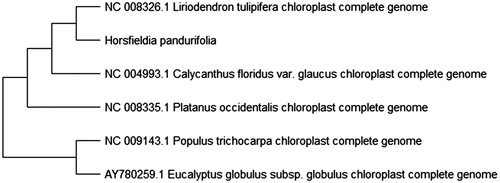Abstract
Horsfieldia pandurifolia is a member of Myristicaceae. The H. pandurifolia chloroplast genome is found to be 155,695 bp in length and has a base composition of A (30.01%), G (19.31%), C (19.90%), and T (30.78%). The genome contained two short inverted repeats (IRa and IRb) regions (48,062 bp) which were separated by a large single copy (LSC) region (92,561 bp) and a small single copy (SSC) region (15,072 bp). The genome encodes 121 unique genes, including 86 protein-coding genes, 27 transfer RNA (tRNA) genes, and 8 ribosomal RNA (rRNA) genes. Further, complete chloroplast sequence of H. pandurifolia was aligned together with five other species which have reported the complete chloroplast sequence. This complete chloroplast genome will provide valuable information for the development of DNA markers for future species resource development and phylogenetic analysis of H. pandurifolia.
Horsfieldia pandurifolia, belongs to Myristicaceae, is a tall arbour tree (Yunnan Institute of Botany Citation1977). Because of its seeds are rich in predominantly fourteen carbonate oil (Mao et al. Citation2017), which can be used as a condensing agent, medical health, beauty and cosmetics and other industrial products of high-quality raw material, so there is a high development value of tree species. The study for H. pandurifolia has been focussed on morphology, grease composition and AFLP analysis by now (Wu, Duan, Tian et al. Citation2011; Wu, Duan, Xu et al. Citation2011; Li et al. Citation2017; Mao et al. Citation2017), and there was controversial about the phylogeny status (Wu et al. Citation2015). In this study, we characterized the complete chloroplast genome sequence of H. pandurifolia for phylogenetic analysis. The annotated genome sequence has been deposited Genbank under the accession number MH445441.
The material of H. pandurifolia was collected in 2017 from Yunnan Institute of Tropical Crops, China. Total genome DNA was extracted from fresh leaves using the DNeasy Plant Mini Kit (QIAGEN, Valencia, CA). Genome sequencing was performed using Roche/454, sequencing libraries were prepared by the GS Titanium library preparation kit. The chloroplast genome assembled using CLC Genomic Workbench v3.6 (http://www.clcbio.com). The genes in the chloroplast genome were predicted using the DOGMA program (Wyman et al. Citation2004). A circular map of H. pandurifolia chloroplast genome was subsequently drawn using web-based program, OGDRAW (Lohse et al. Citation2013).
The circular genome is 155,596 bp in size and comprises a large single copy (LSC) region (92,561 bp), a small single copy (SSC) region (15,072 bp), and two short inverted repeats (IRa and IRb) regions (48,062 bp). The base composition of the circular chloroplast genome is A (30.01%), G (19.31%), C (19.90%), and T (30.78%). GC content of 39.21% for the whole H. pandurifolia chloroplast genome. The H. pandurifolia chloroplast genome encodes a total of 121 unique genes, including 86 protein-coding genes, 27 transfer RNA genes, and 8 ribosomal RNA genes. There were 37 genes duplicated in the IR regions. The LSC region contained 75 genes, which including 58 protein-coding genes and 17 tRNA genes, whereas 3 protein-coding genes, 2 tRNA gene and 4 rRNA genes were included in the SSC region. The introns were detected in 11 genes, trnQ-UUG, rps19-fragment, psbB, trnS-GGA, rpoB, atpH, rps7, trnV-GAC, ndhH, rpl23, trnL-CAA.
To study H. pandurifolia’s phylogenetic relationship with the angiosperms, at the same time, there was no complete chloroplast sequence of Myristicaceae reported, so five complete chloroplast genome sequences of angiosperms were downloaded for analyses. The maximum likelihood phylogenetic was performed using MEGA X (Kumar et al. Citation2018) (). A bootstrap analysis was performed on the resulting phylogenetic tree, and values were obtained after 1000 replications. The result shows that H. pandurifolia was clustered with other species and closely to Liriodendron tulipifera chloroplast complete genome.
Figure 1. Maximum likelihood phylogenetic tree of H. pandurifolia with 5 species based on complete chloroplast genome sequences. The gene’s accession number is listed in the figure.

The complete chloroplast genome of H. pandurifolia would provide information on species resource development and phylogenetic analysis in the future.
Acknowledgements
We thank the editor and anonymous reviewers for providing valuable comments on the manuscript.
Disclosure statement
The authors report no conflicts of interest. The authors alone are responsible for the content and writing of this article.
Additional information
Funding
References
- Kumar S, Stecher G, Li M, Knyaz C, Tamura K. 2018. MEGA X: molecular evolutionary genetics analysis across computing platforms. Mol Biol Evol. 35:1547–1549.
- Li XQ, Zhang FL, Mao CL, Yang T, Qiu YF, Yang XL, Wu Y. 2017. Variation analysis on leaf of Horsfieldia pandurifolia. J Northwest Forestr Univer. 32:143–149.
- Lohse M, Drechsel O, Kahlau S, Bock R. 2013. OrganellarGenomeDRAW—a suite of tools for generating physical maps of plastid and mitochondrial genomes and visualizing expression data sets. Nucleic Acids Res. 41:W575–W581.
- Mao CL, Zhang FL, Yang XL, Xu YL, Duan AA, Wu Y, Zhang H. 2017. Variation tendency for percentages of main fatty acids from Horsfieldia pandurifolia seed. J Southwest Univer (Nat Sci Ed). 39:76–82.
- Wu Y, Duan AA, Tian YH, Xu YL, Zeng JS, Guo XM, Hu YH. 2011. Investigation of wild resource of a rare oil tree Horsfieldia pandurifolia in Yunnan. Guihaia. 31:217–221.
- Wu Y, Duan AA, Xu YL, Tian YH, Yang XL, Hu YH. 2011. Variation analysis on growth traits on seedling of a rare oil tree species Horsfieldia pandurifolia. J Northwest Forestr Univer. 26:88–92.
- Wu Y, Mao CL, Zhang FL, Yang XL, Zeng JS, Duan AA. 2015. Taxonomic position of Horsfieldia pandurifolia Hu (Myristicaceae). Bull Botanical Res. 35:652–659.
- Wyman SK, Jansen RK, Boore JL. 2004. Automatic annotation of organellar genomes with DOGMA. Bioinform. 20:3252–3255.
- Yunnan Institute of Botany. 1977. Flora Yunnanica. Vol.1. Beijing Science Press; 8–13.
